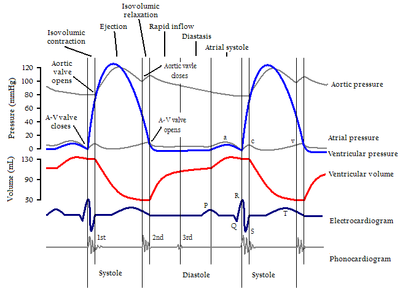
Diastole
Encyclopedia

Systole (medicine)
Systole is the contraction of the heart. Used alone, it usually means the contraction of the left ventricle.In all mammals, the heart has 4 chambers. The left and right ventricles pump together. The atria and ventricles pump in sequence...
(contraction). Ventricular
Ventricle (heart)
In the heart, a ventricle is one of two large chambers that collect and expel blood received from an atrium towards the peripheral beds within the body and lungs. The Atria primes the Pump...
diastole is the period during which the ventricles are relaxing, while atrial
Atrium (anatomy)
In anatomy, the atrium , sometimes called auricle , refers to a chamber or space. For example, the term is used for a portion of the lateral ventricle in the brain and the blood collection chamber of the heart...
diastole is the period during which the atria are relaxing. The term diastole originates from the Greek word διαστολη, meaning dilation.
Inside the heart

Systole (medicine)
Systole is the contraction of the heart. Used alone, it usually means the contraction of the left ventricle.In all mammals, the heart has 4 chambers. The left and right ventricles pump together. The atria and ventricles pump in sequence...
. When the pressure in the left ventricle drops to below the pressure in the left atrium, the mitral valve
Mitral valve
The mitral valve is a dual-flap valve in the heart that lies between the left atrium and the left ventricle...
opens, causing accumulated blood from the atrium to flow into the ventricle. An easy way to think about this, though untrue, is that diastole is a sump
Sump
A sump is a low space that collects any often-undesirable liquids such as water or chemicals. A sump can also be an infiltration basin used to manage surface runoff water and recharge underground aquifers....
that induces suction of blood into the heart to prepare for the next pump
Pump
A pump is a device used to move fluids, such as liquids, gases or slurries.A pump displaces a volume by physical or mechanical action. Pumps fall into three major groups: direct lift, displacement, and gravity pumps...
of systole. The heart is actually filled by the momentum of the blood flowing from the previous systolic cycle, with the "atrial kick" serving as a way to "hoist" the ventricular myocardium over the mass of blood contained within the chamber just prior to systole.
The ventricular filling velocity or flow into the ventricles have two main components; First an early (E) diastolic one caused by accumulation of blood in the atria during previous systole, and second, a late one created by atrial contraction (A). The E/A ratio
E/A ratio
The E/A ratio is the ratio between early and late ventricular filling velocity.The early diastolic one is caused by accumulation of blood in the atria during previous systole, and second, a late one created by atrial contraction .In a young and compliant heart, early ventricular filling accounts...
can be used as a diagnostic measure, since it is reduced in diastolic dysfunction
Diastolic dysfunction
Diastolic heart failure or diastolic dysfunction refers to decline in performance of one or both ventricles of the heart during the time phase of diastole...
.
Inside the arteries
The adjective "diastolic" is used to refer to filling of the heartHeart
The heart is a myogenic muscular organ found in all animals with a circulatory system , that is responsible for pumping blood throughout the blood vessels by repeated, rhythmic contractions...
with blood between muscle contractions. It is used to describe the opposite portion of the cardiac cycle
Cardiac cycle
The cardiac cycle is a term referring to all or any of the events related to the flow or blood pressure that occurs from the beginning of one heartbeat to the beginning of the next. The frequency of the cardiac cycle is described by the heart rate. Each beat of the heart involves five major stages...
related to contraction. More typically it is used as one component of measurement of blood pressure
Blood pressure
Blood pressure is the pressure exerted by circulating blood upon the walls of blood vessels, and is one of the principal vital signs. When used without further specification, "blood pressure" usually refers to the arterial pressure of the systemic circulation. During each heartbeat, BP varies...
. "Diastolic pressure" refers to the lowest pressure within the arterial blood stream occurring during each heart beat. The other component of blood pressure is systolic pressure
Systole (medicine)
Systole is the contraction of the heart. Used alone, it usually means the contraction of the left ventricle.In all mammals, the heart has 4 chambers. The left and right ventricles pump together. The atria and ventricles pump in sequence...
, which refers to the highest arterial pressure during each heart beat.
When blood pressure is stated for medical purposes, it is usually summarized
Abuse of notation
In mathematics, abuse of notation occurs when an author uses a mathematical notation in a way that is not formally correct but that seems likely to simplify the exposition or suggest the correct intuition . Abuse of notation should be contrasted with misuse of notation, which should be avoided...
as a "ratio" of systolic to diastolic pressure; for example: 120/80 mmHg. However, this is not a true ratio: it cannot be reduced into lower terms.

